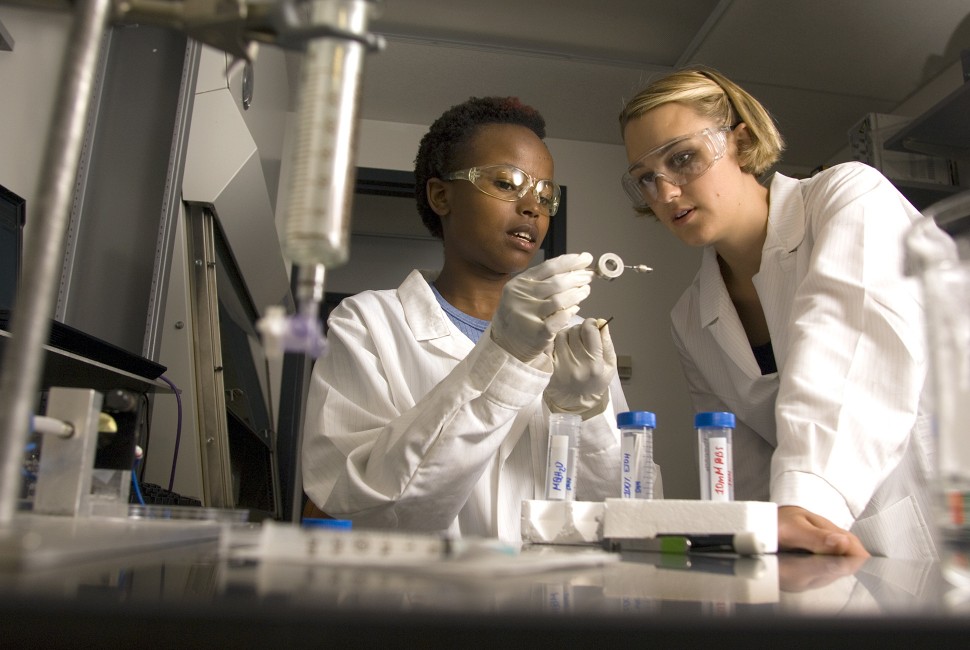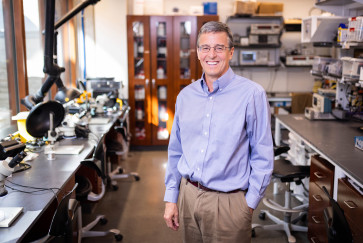Northwestern’s Ryan Fellows are changing the world, leading innovations in everything from medicine to manufacturing to materials science. Now in its 15th year, the community of more than 200 fellows spans the globe, bound only by science’s smallest unit of measurement.
The Ryan Fellows program supports graduate students dedicated to the exploration of fundamental nanoscale science — and turning that knowledge into practical applications that benefit society — thanks to a generous gift from the Patrick G. ’59, ’09 H and Shirley W. Ryan ’61, ’19 H (’97, ’00 P) Family.
“This program invests in people rather than projects,” said Chad Mirkin, director of the International Institute for Nanotechnology (IIN), which manages the Ryan Fellows program. “And because of that, we get to see so many breakthroughs along the way.”
“Ryan Fellows have invented tools that changed the practice of medicine and changed how we study and treat disease,” Mirkin said. “They’ve contributed to advances in manufacturing and the development of the world’s highest-throughput 3D printer. They have discovered ways of making highly miniaturized electronics that are used for all sorts of purposes, including computing. And they have transformed how we discover new materials by using artificial intelligence and big data.”
Over the past 15 years, 10 departments across Northwestern have funded 218 fellows. Approximately 50% of Ryan Fellows have gone on to careers in academia; 44% are in industry; 4% are employed at other institutions, such as governmental agencies, national laboratories, nonprofit organizations and hospitals; and 2% are continuing their education.
In honor of the 15-year anniversary of the Ryan Fellowship, Mirkin and two other faculty members involved in the program — Vinayak Dravid and Michael Jewett — talked with Northwestern Now about the impact the program has had at the University and beyond.
How has the fellowship enhanced Northwestern’s graduate student experience?
Jewett: The Ryan Fellows program helps Northwestern recruit the best and brightest students. The program creates a community of likeminded souls who complement one another because they come from so many different disciplines. As a Ryan Fellow, you do great things here at Northwestern, and it is expected you’ll continue to do great things once you leave.
Mirkin: That was the genius of Pat and Shirley Ryan — that the Ryan Fellows program would be something that’s going to move the needle at Northwestern in the here and now, and it’s also something that’s going to pay enormous dividends down the road because it’s an investment in incredible people all over the world.
Dravid: I talked to my students going back many years about the Ryan Fellowship, and they appreciate the flexibility of the research opportunities, which enable them to go to places and explore topics that might have been impossible otherwise.
What are some key opportunities available through the program?
Mirkin: One of most exciting things about the Ryan Fellowship is the team-building element. They have a community, and they present to one another on a regular basis throughout their entire career at Northwestern. From those presentations, they get ideas on how to collaborate with one another, and those collaborations can lead to computational people gearing up with synthetic people gearing up with engineers — to create discoveries or solutions to major problems that just can’t happen by themselves.
Dravid: The Ryan Fellowship allows students to interact with domestic and international partners and helps launch synergistic programs revolving around nano. We’ve launched an Indo-U.S. program with India, Singapore and Israel to create a global network.
Can you explain a few current projects?
Jewett: Adam Silverman, a joint student of mine with Julius Lucks, developed a portable diagnostic to detect lead in water. What’s so cool is that his advances hold promise to enable anyone, anywhere to detect lead or myriad other contaminants in water in their own homes in under an hour.
Dravid: Recently in my lab, fellows including Stephanie Ribet developed a nanoscale coating to sequester pollutants ranging from nutrients to oil to microplastics. Now, we will be able to help following natural disasters to clean up dangerous toxins from water and tackle problems associated with algae bloom.
In addition to leading IIN, Chad Mirkin is the George B. Rathmann Professor of Chemistry at the Weinberg College of Arts and Sciences, professor of chemical and biological engineering, biomedical engineering, materials science and engineering at the McCormick School of Engineering and a professor of medicine at Northwestern University Feinberg School of Medicine.
Vinayak Dravid is the Abraham Harris Professor of Materials Science and Engineering at Northwestern’s McCormick School of Engineering and the founding director of the Northwestern University Atomic and Nanoscale Characterization Center.
Michael Jewett, the Walter P. Murphy Professor of Chemical and Biological Engineering at McCormick, directs Northwestern’s Center for Synthetic Biology.


